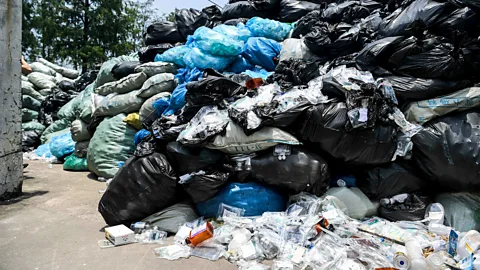The placentas fuelling hospital kitchens in Nepal
The burning of medical waste poses a serious health and environmental danger. Hospitals in Nepal have started turning this hazardous waste into cooking gas.
Hospital staff close to the incinerator complained of persistent coughs, breathing difficulties, headaches, sore eyes and rashes. The black, noxious smoke that poured out of its chimney wafted in through the windows of Tribhuvan University Teaching Hospital (TUTH) in Nepal’s capital Kathmandu. Staff reluctantly closed them to protect their vulnerable patients: children and babies in paediatric and neonatal intensive care, and adults with respiratory illnesses.
“Keeping the windows shut caused the rooms to overheat and added to the discomfort,” recalls Deepak Mahara, former TUTH executive director who has now retired. “When the incinerator was operational, smoke frequently drifted into these sensitive areas, causing significant distress. The foul smell made the work environment uncomfortable.”
Despite this, no one realised their symptoms were connected to the incinerator’s emissions until 2014, when a local non-profit, the Health Environment and Climate Action Foundation (HECAF360), approached hospital managers to suggest replacing the offensive furnace with an underground biodigester. Staff not only faced long-term health conditions if they continued to be exposed to the poisoned air, but the hospital was also causing broader public health and environmental dangers, HECAF360 warned. Low-quality incineration of health care waste releases dioxins and furans into the atmosphere – chemicals both classified as human carcinogens. While medical waste that is dumped outside of hospital grounds poses risks to anyone who may come into contact with it, such as waste pickers on dump sites.
“We were unaware of the negative impact of the mismanagement of healthcare waste,” says Mahara. Realising the issue was serious, he agreed to take action. “It needed to be addressed immediately to comply with hospital’s mission to ‘do no harm’,” he says.
 Alamy
AlamyThe situation at TUTH is common. Hospitals worldwide use incinerators to eradicate rubbish. It is the method most commonly used in developing countries to dispose of infectious waste, according to a UN Human Rights Council report. The report highlights that if medical facilities have small-scale incinerators, or manage them incorrectly, this can lead to dioxins emissions that are 40,000 times higher than emission limits set forth in the Stockholm Convention on Persistent Organic Pollutants.
In Nepal, hospitals and healthcare centres generate between 1 and 1.7kg (2.2 and 3.7lb) of healthcare waste per bed each day, according to Health Care Without Harm (HCWH), a global non-profit working to reduce healthcare services’ negative impacts on the environment and people. One study estimates low-income countries produce up to 6kg (13.3lb) of hazardous waste per bed per day, which rises to 11kg (24.3lb) in high-income nations.
The safe approach to medical waste management is to separate and treat wastes differently. According to the World Health Organization (WHO), 15% of healthcare waste is hazardous material that may be infectious, toxic or radioactive. Waste must all be segregated before disposal, but just one-third of healthcare facilities do this. This has a detrimental impact on people and the planet. About 5.2 million people, including four million children, die each year from waste-related diseases around the world.

